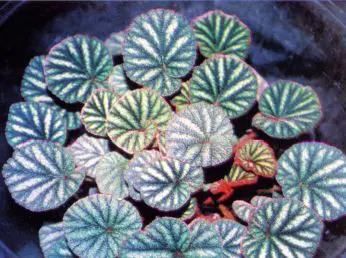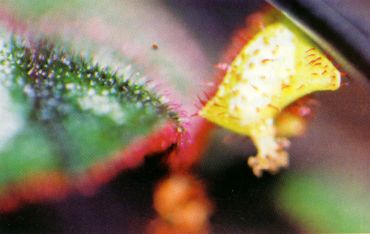Begonia versicolor is a rhizomatous begonia from central China. It was discovered by Dr. Edgar lrrnscher in 1939. It requires a terrarium culture, preferring to grow in long fiber sphagnum moss.
Leslie Woodriff called it the “Fairy Carpet” begonia because of the velvety appearance of its dark green leaves, frosted with silver and covered with thick red hairs, especially down the veins. Leaf size varies from 3″ to 7″ depending on how it is grown.
The backs of the pink flowers are covered with dark red hairs, as are the ovaries of the female flowers.
Leslie Woodriff once described benches full of B. versicolor in his greenhouses in Harbor, Oregon. They were grown in pots on the bench. Harbor is on the coast of southern Oregon where the climate is moderate and moist. Most of us grow B. versicolor in an enclosed container.
I fertilize by spritzing the leaves once a month with 1/4 strength 10-10-10 liquid fertilizer. Since the plants are grown under lights, they grow fast and need some fertilizer because the moss provides very little nourishment.
If the moss shows a white crust it is getting too much fertilizer and the moss may need to be leached by submerging the moss in water and then removing the water. The process may need to be repeated several times to get rid of the salt.
B. versicolor’s worst enemy is heat. It does not like the hot weather of summer. I have lost many a B. versicolor due to summer heat. I keep mine in the coolest part of the house and only run the lights at night when the temperature is cooler.
Even though B. versicolor has been around since 1939, it has never been in wide circulation and has seldom been advertised in plant catalogues. More begonia fans should grow it since it is easy to grow provided it gets good light but not sunlight, and it is kept cool.
I have not seen everybody’s catalog recently, but I know it is available through Cloudy Valley Nursery and Kartuz Greenhouses.
Give B. versicolor a try. It is a beautiful begonia. By growing it you will not only be able to admire it’s beauty, but you will also be helping to save a species.



